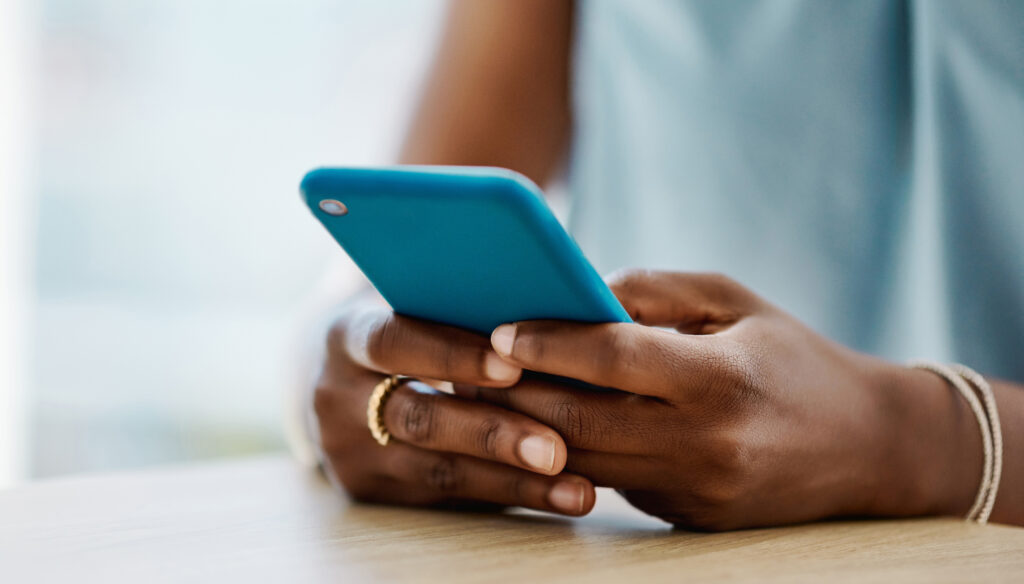When’s the last time you thought you needed a break from your phone?
For many of us, cell phones are an unavoidable — and often really wonderful — part of life. They’ve become so integrated into the ways we work, move, connect, and exist that we frequently use them without even noticing, peering down in small moments that slip away as quickly as they started.
Research has shown that Americans check their smartphones 50 to 80 times each day, and a 2022 report determined that most people use mobile phones for more than four hours a day — roughly a third of our waking lives. So just like nearly anything we do, especially anything we do in excess, there can be downsides.
Overuse of smartphones has been linked to both physical and mental health issues, and as the tech is relatively new, there’s still some mystery regarding what could happen in the long run.
But here’s the good news: Experts, authors, and psychologists have practical tips to help us set meaningful boundaries with our phones. And because phones are so intertwined with our everyday lives, it stands to reason that the more intentionally we use them, the more intentionally we live beyond our screens — in our interactions with the world, other people, and even ourselves.

Ask Yourself: How Do I Want to Interact With My Phone?
How much screen time is too much? This answer is different for everyone.
Catherine Price, journalist and author of How To Break Up With Your Phone told NPR, “I feel like there’s all these ‘shoulds’ that we always put on ourselves instead of asking: What is right for us?” She added: “Really look at your own screen habits and try to figure out what you actually want your boundaries and routines to look like with your devices.”
So check in with yourself about how your phone is making you feel and what, if anything, you’d like to change. This may help you identify certain apps that are sucking your energy, or needless habits like constantly checking emails or refreshing a certain website.
If you’re excited to dive head first into a phone breakup, we highly recommend Price’s book and 30-day course that culminates in a 24-hour phone-free challenge.
Make Your Phone Less Appealing
WIRED recommends setting your screen to “grayscale.” This removes the pretty colors from your apps and photos, turning everything black and white. Sounds dull, right? Exactly! Here’s how to do it on Androids and iPhones.
Opting for a plain phone case and swapping your wallpaper and lock screen for unstimulating images (i.e. not a cute picture of your dog) are two other ways to make your phone less exciting.
Remove Notifications
It’s hard to resist looking at your phone when it’s essentially begging you to pick it up and see what’s “new.”
Clinical psychologist Nicole Beurkens told CNBC’s Make It, “Many teens and adults find that turning off all, or almost all, notifications is helpful. At a minimum, notifications from social media apps should be disabled, or anything that is going to distract attention away from other things on a regular basis throughout the day.”
Focus Mode is another helpful way to keep your concentration on a task, whether you’re driving, working, or spending quality time with family.
“At a minimum, notifications from social media apps should be disabled, or anything that is going to distract attention away from other things on a regular basis throughout the day.”
Clinical psychologist Nicole Beurkens
Take It Slow
In an interview with Popular Science, psychologist Larry Rosen, author of The Distracted Mind: Ancient Brains in a High-Tech World, suggested a gradual approach to reducing phone time, focusing on breaking the pattern of checking it every 10 or 15 minutes that so many people fall into. “You can’t detox cold turkey,” he said. “Putting your phone away for the weekend might seem like an easy solution, but it’s just going to make you highly anxious.”
Instead, start by turning your phone on silent, placing it face down in front of you, and setting an alarm for 15 minutes, Rosen advises. Repeat that process until the urge to check after the 15 minutes is over feels less intense — and then go up to 20 minutes. The goal? “I would encourage people to get up to checking at least every 30 minutes, because that cuts down that typical 15-minute behavior in half,” he said.

Be Mindful of Your Phone Checks
Constant phone checking is associated with stress and feelings of disconnection, but there are ways to add mindfulness to the habit, Price told WBUR, “I recommend that you create what I call a ‘speed bump’ for yourself — some little obstacle that makes you stop and have to decide whether or not to continue.” One of her examples of a “speed bump” is a lock screen wallpaper with a question like, “Do you really want to pick me up right now?”
In her phone breakup course, Price also suggests simply asking the question: “What’s the best thing that could happen when I pick up my phone?”
Note: If you find it hard to not check your phone, it isn’t evidence of your lack of strength or willpower. As Vox states: “It’s not you. Phones are designed to be addicting.”
“I recommend that you create what I call a ‘speed bump’ for yourself — some little obstacle that makes you stop and have to decide whether or not to continue.”
Author Catherine Price
Declutter Your Phone
A tried-and-true tip is to keep your phone as minimalistic as possible. Remove apps that you don’t use or don’t want to use. This will not only help you avoid things you don’t need, but also keep your attention on things that are actually helpful.
Wirecutter suggests another decluttering hack: Set up your phone to automatically clear text messages at a certain time and back up and delete your photos to free up storage space.
Set Phone-Free Zones

While setting screen-free zones is common advice from psychologists for kiddos, it can also be applied to adults who want to set boundaries. For example, keeping your phone out of your bedroom or away from the dining table will help you spend more time on other things like sleeping, chatting, or simply being.
Keeping a phone within arm’s distance of where you sleep, like under your pillow or on your bedside table, can negatively affect your sleep and overall health. The general rule of thumb is to put it away an hour or two before bed.
Write Down Phone-Free Activities You Enjoy
Research has shown that an effective way to break a habit is to replace it with something new. Consider making a running list of activities you enjoy doing without your phone, and keep it handy next time you want to take a phone break. Need a little inspiration? Here’s a roundup of suggestions:
Take a nap! Studies show they’re good for your brain, so go ahead and snooze guilt-free
Flip through a magazine
Read a few pages of a book (check out some of Nice News’ recommended reads)
Meditate
Go for a silent walk
Do a puzzle
Write in a journal —start by jotting down a few things you’re grateful for and see where it goes from there
Bake or cook a recipe you love, or try out a new one
Paint your nails
Do a little cleaning, organizing, or tidying up
Look out a window while sipping tea or coffee
Play with your pet
Chat with a partner, roommate, or neighbor
Write an impromptu thank you note to a friend
Doodle
Move your body with a yoga flow or home workout (maybe try one of these free online classes)
Take a bath or a soothing shower
Give birdwatching a go
Try mindful coloring
People watch
Light a candle, put on some feel-good music, and slow down
Be okay with being a little bored! A little boredom can actually benefit your brain
Again, there’s so much to be grateful for when it comes to technological innovations. But maybe, the more we manage what we don’t like about our phones, the more we’ll appreciate what we do like about them, like using them to reach out to friends and take cute photos of our pets — even if we don’t put them on our lock screen.
RELATED: From Smiling to Sleeping: 10 Ways to Feel Happier, According to Science












